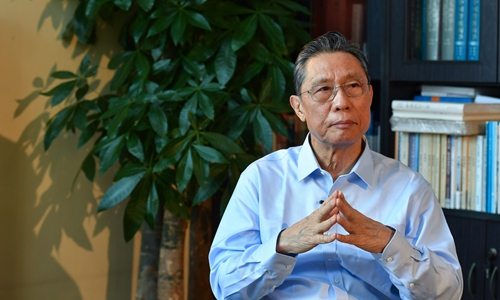HOME >> CHINA
Zhong Nanshan discovers human-to-human transmission in early stages of COVID-19 outbreak
Source:Globaltimes.cn Published: 2020/3/20 2:43:07 Last Updated: 2020/3/20 5:24:49

Chinese renowned respiratory scientist Zhong Nanshan receives an interview with Xinhua in Guangzhou, South China's Guangdong Province, Jan. 28, 2020. (Xinhua/Liu Dawei)
Before going to Central China's Hubei Province to look into the coronavirus outbreak, Zhong Nanshan, head of the National Health Commission's team investigating the novel coronavirus outbreak, heard about suspected cases in South China's Guangdong Province, where Zhong currently works, and found evidence of a cluster of infection in a family.
On January 16, Guangdong held an emergency meeting where Zhong learned more about the situation. When he arrived in Hubei, Zhong said he had received many calls from his students, including some doctors who were part of medical teams dispatched by the central government.
"What surprised me was they were all somewhat depressed and the situation they outlined contradicted what I heard later," he said, noting that the situation in Hubei at that time was actually much more severe than what was reported by local authorities or in the media.
He said before he saw infections in medical staff in a major hospital in Wuhan, he had been asking questions about it. For an imminent public health incident, this was a very dangerous signal, as cluster infections from human-to-human transmission would accelerate the spread of the disease.
On December 30, some doctors noticed a cluster of infection in three members of one family, which should have aroused the attention of local centers for disease control and prevention (CDC), Zhong said, noting that, however, they did not attach sufficient importance to it.
The lack of attention later caused a delayed response, which further accelerated the spread of the disease.
A family of six patients traveled to Wuhan from Shenzhen between December 29, 2019 and January 4, 2020, according to a research paper published in the medical journal The Lancet on January 24.
Of the six family members who traveled to Wuhan, five were identified as infected with the novel coronavirus. Additionally, another family member who did not travel to Wuhan, became infected after several days of contact with four members of the family.
As a veteran medical expert, who closely advises the central government on the outbreak, Zhong suggested that the CDC should have administrative power, in other words, besides gathering information, undertaking technical identification and making judgments in an emergency, the CDC should publicly report the situation, thereby immediately raising public awareness. And the public would then be able to implement preventive measures and exercise caution.
On January 23, the central government ordered a citywide lockdown in Wuhan, which was considered a drastic way of curbing the virus spread. Zhong made a presumption that if the measure had been implemented five days earlier, there would have been about 20,000 confirmed patients nationwide.
If the measure had been delayed for five more days, the number of infection cases would peak at around 170,000 nationwide by March, which also shows that early prevention is very important.
Such a crucial decision should be made by the CDC. When it's urgent and necessary, it could send out warnings to the public.
Posted in: SOCIETY